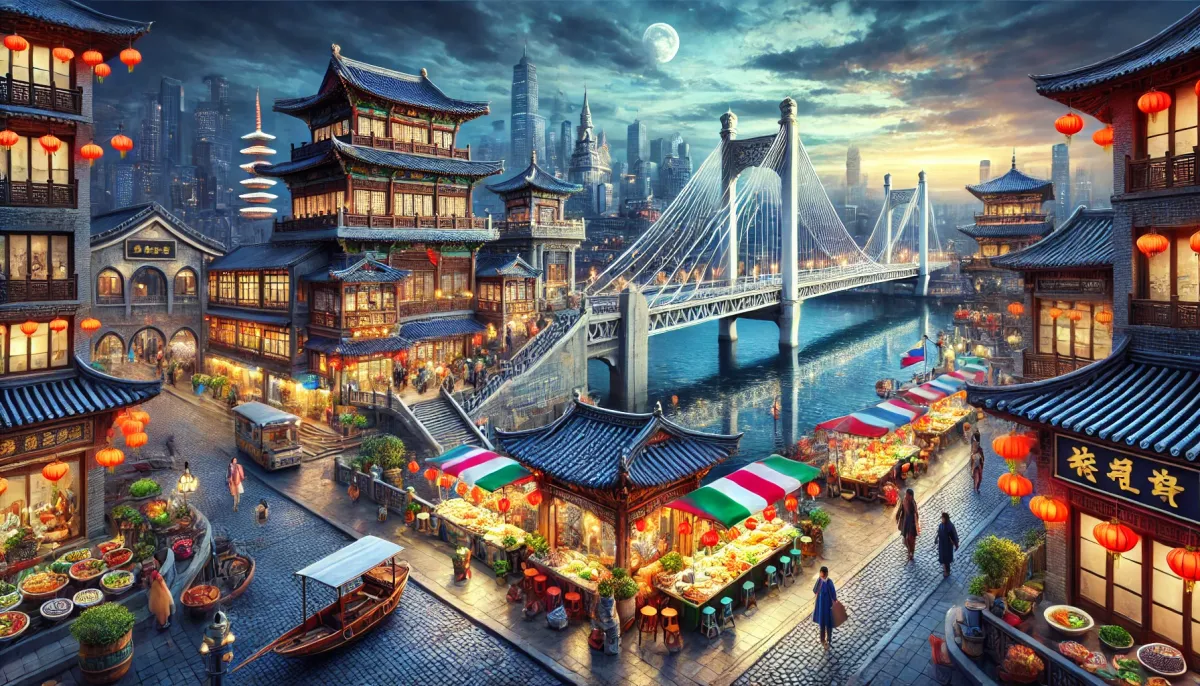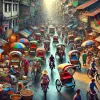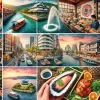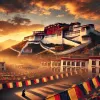Hey everyone, Mark here! I'm back with another travel story, this time from a city that really surprised me: Mudanjiang, China. Located in Heilongjiang province, this city, named after the Mudan River, isn’t typically on the tourist radar, but it’s a hidden gem with a fascinating history and culture. Let me share my adventure with you.
A Journey by Rail: From Suifenhe to Mudanjiang
After my time in Suifenhe, a border town with a strong Russian influence, I hopped on a train to Mudanjiang. I took the K2052, part of the Suifenhe-Harbin railway, a section of the Suifen-Manzhouli railway (also known as the Suiman Railway). Many cities along this line owe their development to the railway, a fascinating historical connection. While a high-speed Harmony train whizzed past, I opted for the charm of a slower, green-car train, a nostalgic experience in itself. Suifenhe station, I noted, proudly displayed signs in Chinese, Russian, and English, a testament to its border location.
First Impressions: Fighter Jets and Affordable Eats
My arrival in Mudanjiang was quite dramatic! As I exited the station, I was greeted by a series of fighter jets screaming overhead – a truly unexpected welcome! My hotel room was basic but comfortable, a clean and spacious room with all the necessities.
The city’s temperature was considerably warmer than Suifenhe (14-15°C). I headed to a popular local eatery for lunch, impressed by the affordable prices. I enjoyed a delicious and inexpensive meal:
| Dish | Price (CNY) | Price (USD) | Notes |
|---|---|---|---|
| Five-Spice Fried Fish | 28 | ~4 | |
| Mixed Beef Face | 28 | ~4 | |
| Mixed Beef Tripe | 28 | ~4 | |
| Garlic Seaweed Salad | 8 | ~1.1 | |
| Braised Yellow Croaker | ~28 | ~4 | |
| Half portion of Cold Beef | 19 | ~2.7 | |
| Half portion of Tomato and Egg | 7 | ~1 | Slightly too sweet for my taste. |
| Huahua Beer | 5 | ~0.7 | (Price observed in Suifenhe) |
I was particularly impressed by the meticulous way food was portioned, weighed precisely on electronic scales.
Mudanjiang's Rich History and Cultural Influences
Mudanjiang's history is deeply intertwined with the region's diverse cultures. "Mudan" means "winding" in Manchu, reflecting the river's path. The area has been inhabited for over 2,300 years, with influences spanning the Bohai Kingdom (closely linked to the Korean Peninsula), the Ming and Qing dynasties, and the construction of the Chinese Eastern Railway in 1898 which spurred the city's growth.
The city has a significant Korean population (approximately 70,000, the second largest ethnic group after Han Chinese), resulting in a visible Korean cultural presence. The Russian influence, particularly evident near the border, is also captivating, with glimpses of Russian architecture and cuisine.
Modern Mudanjiang: A Blend of Old and New
Mudanjiang boasts a bustling city center with modern amenities but retains a sense of traditional Northeast charm. I strolled through a commercial street, noticing a mix of traditional and modern shops, with lingering traces of Russian influences in the architecture. The city's airport's proximity to the city center meant drone usage was restricted.
The city's vibrant night markets showcased a fusion of international cuisines:
| Food | Price (CNY) | Price (USD) | Notes |
|---|---|---|---|
| Sugar-coated Chestnuts | 9.9/jin | ~1.4 | Per kilogram |
| Longans | 12/kg | ~1.7 | Surprising to find tropical fruit here! |
I even spotted some longan (dragon eye fruit), a tropical fruit from my childhood, sold at the market! The city's cultural square, once vast and open, is now filled with smaller stalls, reflecting the city's efforts to stimulate local consumption and employment.
Exploring the City: From the Riverside to the City Center
I rented a shared bicycle (a rarity in smaller border towns, but readily available in a city of Mudanjiang's size) and explored the city further. The riverside offered stunning views, and I learned of the increasing number of elderly people moving south during the winter months, particularly to Hainan, Guangdong, and Guangxi, due to lower living costs.
I also noticed the numerous fitness areas populated by older residents and massage stands along the river, a testament to the community's active lifestyle.
I read articles about Mudanjiang's significant population loss, a common issue in Northeast China due to job opportunities and harsh weather. This was visible in some areas of the city I visited.
Iconic Landmarks and Natural Beauty: The Mudan River and Beyond
My journey led me to the Mudanjiang Bridge, a magnificent structure reminiscent of the Alexandre III Bridge in Paris. The bridge offers breathtaking views of the river, its wide expanse sometimes revealing a significant amount of exposed riverbed. The river itself, with its black waters flowing through the black earth, evoked the iconic image of "white mountains and black waters" often used to describe Northeast China.
A visit to Jiangxin Island, a serene oasis in the middle of the river, provided a tranquil escape. The island's tranquil atmosphere, beautiful scenery, and friendly locals left a lasting impression.
A Culinary Delight: Authentic Anhui Beef Noodles
One of the highlights of my trip was discovering a local noodle shop serving authentic Anhui beef noodles. This unassuming eatery, recommended by an online review, offered an incredibly flavorful and affordable meal:
| Item | Price (CNY) | Price (USD) | Notes |
|---|---|---|---|
| Small Anhui Beef Noodles | 9 | ~1.3 | Includes a generous portion of beef and an egg! |
| Added Duck Neck | 1 | ~0.14 | |
| Added Bean Curd Skin | 1 | ~0.14 | |
| Bottle of Water | 2 | ~0.28 |
The rich, dark broth, spicy chili oil, and tender duck neck were unforgettable. The owner, a young man whose parents started the business over 20 years ago, had inherited and continued the family legacy, creating a humble but delicious eatery.
Experiencing Northeastern Bathing Culture: A Unique Encounter
I finally experienced the renowned Northeastern bathing culture. For 40 CNY (around $5.7 USD; including 20 CNY entry fee and 20 CNY for the scrub), I received a full-body scrub. This experience, which included a thorough washing, vinegar rinse, and a vigorous scrub, was quite unique. I discovered that the overall cost was actually 56 CNY after additional charges for towels and vinegar.
While I found the experience initially awkward due to my upbringing in the South, the locals took it in stride. It's a cultural norm that emphasizes cleanliness and relaxation.
Korean Influence and Mudanjiang's Unique Identity
A significant aspect of Mudanjiang is its sizable Korean population. I visited a Korean-themed street, where shop names and signage incorporated both Chinese and Korean characters. This cultural blending underscored the city's unique character, a blend of Chinese, Korean, and Russian influences. The large Korean population also explains the prevalence of dog meat restaurants in the city.
Mudanjiang's Future: Challenges and Opportunities
My overall impression of Mudanjiang is a city with a rich history, a diverse cultural tapestry, and friendly locals. However, it faces challenges. The population outflow, as mentioned earlier, is a concern, as is the need to diversify its economy. Despite this, there are signs of progress, with efforts to promote tourism and local businesses.







